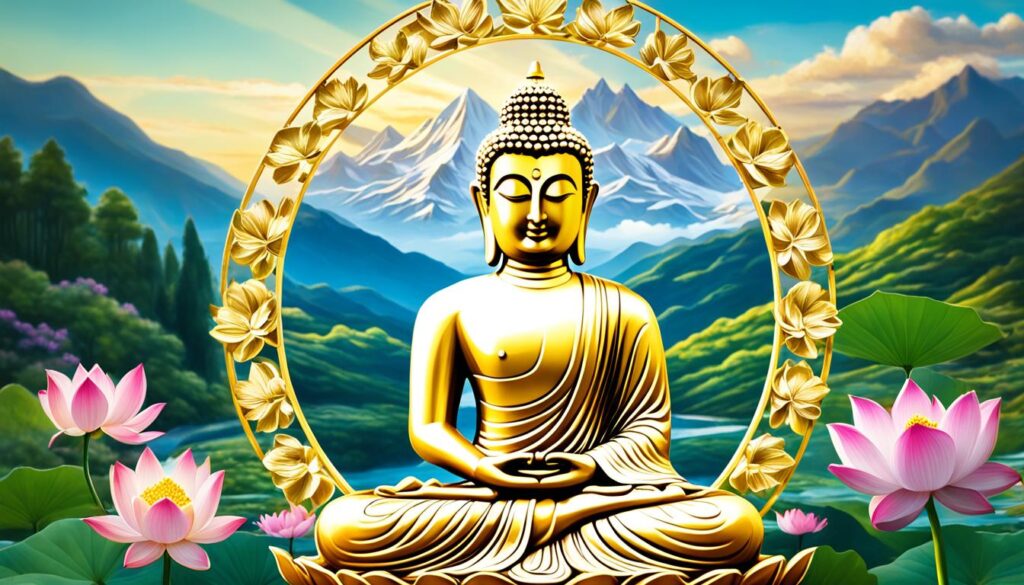“Do not dwell in the past, do not dream of the future, concentrate the mind on the present moment.” – Buddha
Welcome to a journey into the timeless wisdom of Buddhism, where enlightenment and inner peace await. Buddhism is not just a religion; it is a philosophy that offers profound insights into the nature of existence and the human mind. In this article, we will uncover a fascinating fact about Buddhism that will ignite your curiosity and inspire you on your spiritual path.
Throughout history, Buddhism has captivated the hearts and minds of millions, spreading its teachings across continents and cultures. Rooted in mindfulness, compassion, and addressing the universal challenges of humanity, Buddhism provides practical tools for personal growth and societal harmony.
As we embark on this exploration, we will delve into the origins and core beliefs of Buddhism, unravel the path to enlightenment, meet important figures in the tradition, and unravel the rich tapestry of Buddhist traditions and symbols. Are you ready to dive into the depths of Buddhist wisdom? Let’s begin!
Key Takeaways:
- Buddhism is a philosophy that offers insights into existence and the human mind
- Mindfulness, compassion, and addressing human challenges are central to Buddhism
- We will explore the origins, core beliefs, and path to enlightenment in Buddhism
- Important figures in Buddhism have played a significant role in its spread
- Buddhism encompasses diverse traditions and symbols that convey deep meaning
The Origins and Core Beliefs of Buddhism
Buddhism, an ancient and profound philosophy, traces its roots back to around 400 BC with the historical individual known as the Buddha. The term “Buddhism” was coined by Western scholars in the 1830s and is not used by Buddhists themselves to refer to their religion. The Buddha, also known as Siddhartha Gautama, founded the Sangha, an order of monks and nuns who have dedicated themselves to preserving and sharing his teachings.
Buddhism is a diverse tradition with two main branches, Mahayana and Theravada. While there are variations within these branches, there are core beliefs that are shared among Buddhist communities. Central to Buddhist beliefs is the absence of a supreme being or creator god. Instead, Buddhism focuses on the individual’s quest for enlightenment and the understanding of life’s ultimate truths.
Meditation and mindfulness play a vital role in Buddhism, as practitioners aim to develop awareness and cultivate a deep understanding of the mind and body. The practice of meditation allows individuals to observe their thoughts, emotions, and sensations, fostering inner peace and wisdom. Buddhists also believe in the concept of reincarnation and rebirth, where they strive to break free from the cycle of suffering by attaining enlightenment.
Here is a table summarizing the core beliefs of Buddhism:
| Beliefs | Description |
|---|---|
| Absence of a Supreme Being | Buddhism does not worship or rely on a creator god. |
| Meditation and Mindfulness | Practitioners focus on developing awareness and cultivating inner peace through meditation. |
| Reincarnation and Rebirth | Buddhists believe in the cycle of life, death, and rebirth, aiming to achieve enlightenment to end this cycle. |

The Path to Enlightenment
Central to Buddhism are the Four Noble Truths, which address the nature of suffering and the path to liberation. These truths state that life is suffering, suffering arises from attachment and desire, suffering can be ended, and there is a path to the end of suffering, known as the Noble Eightfold Path.
The Eightfold Path consists of the following key teachings of Buddhism:
- Moral Conduct: Practicing right speech, action, and livelihood to cultivate positive relationships and ethical behavior
- Concentration: Developing mental focus and discipline through meditation and mindfulness
- Wisdom: Cultivating insight, understanding, and discernment to see reality as it truly is
Buddhist practices, such as meditation and mindfulness, play a vital role in embodying these teachings and guiding individuals on their spiritual journeys. By engaging in regular meditation, practitioners can cultivate self-awareness, foster a sense of inner peace, and develop compassion for themselves and others.
The practice of meditation allows individuals to quiet their minds, observe their thoughts and emotions, and develop a deeper understanding of their inner workings. Through this process, one can gain insights into the impermanence of all things, the interdependent nature of existence, and the interconnectedness of all beings.

By integrating Buddhist philosophy and practices into daily life, individuals can transform their perspectives and behaviors, leading to greater happiness, fulfillment, and harmony with the world around them.
| Buddhist Practices | Benefits |
|---|---|
| Meditation |
|
| Mindfulness |
|
Important Figures in Buddhism
Siddhartha Gautama, also known as the Buddha, is considered the founder of Buddhism. His teachings and enlightened insights have guided countless individuals on their spiritual journeys towards liberation and inner peace.
Emperor Ashoka, a powerful Indian ruler during the Maurya dynasty, played a significant role in spreading Buddhism across ancient India and beyond. Inspired by the teachings of the Buddha, Ashoka embraced non-violence, compassion, and social welfare, leaving a lasting impact on the development and growth of Buddhism.
The Dalai Lama, the spiritual leader of Tibetan Buddhism, embodies compassion, wisdom, and a deep commitment to peace. Through his teachings, the Dalai Lama continues to inspire millions around the world to cultivate understanding, kindness, and harmony.
Bodhisattvas, enlightened beings who choose to remain in the cycle of rebirth to help others achieve liberation, hold a special place in certain branches of Buddhism. These compassionate figures, such as Avalokitesvara (the Bodhisattva of Compassion) and Manjushri (the Bodhisattva of Wisdom), embody the ideals of selflessness and serve as role models for practitioners seeking enlightenment.
The contributions of these important figures in Buddhism have shaped the philosophy, practice, and dissemination of Buddhist teachings throughout history. Their wisdom, compassion, and dedication continue to inspire and guide spiritual seekers in their pursuit of enlightenment.

Buddhist Traditions and Symbols
Buddhism encompasses various traditions and cultural expressions. From the colorful rituals of Tibetan Buddhism to the serene Zen practice of Japan, each tradition offers unique perspectives on the path to enlightenment.
Buddhist symbols play a significant role in representing fundamental teachings and enlightenment. Two widely recognized symbols are the Dharma Wheel and the Lotus Flower. The Dharma Wheel, also known as the Dharmachakra, symbolizes the Buddha’s teachings and the Eightfold Path. It serves as a reminder of the harmonious way of living that leads to liberation from suffering. The Lotus Flower represents purity and spiritual growth. Just as the lotus blossoms from muddy waters, it symbolizes the potential for enlightenment to arise from the complexities and challenges of life.
One of the most significant aspects of Buddhism is its celebration of festivals, which offer opportunities for reflection, gratitude, and community. Vesak, also known as Buddha Purnima or Buddha Day, is a prominent Buddhist festival that takes place annually to commemorate the birth, enlightenment, and death of the Buddha. This festival brings together Buddhists from various traditions to engage in devotional practices, chanting, and meditation, while also emphasizing acts of generosity and kindness towards others.
Buddhist Traditions
Let’s explore some of the distinct Buddhist traditions and their unique characteristics:
- Tibetan Buddhism: Known for its vibrant rituals, intricate artwork, and mystical practices, Tibetan Buddhism blends elements of Buddhism with indigenous Tibetan beliefs. Monasteries and meditation retreats are integral to Tibetan Buddhist practice, and rituals involving mandalas, prayer flags, and ceremonial instruments are common.
- Zen Buddhism: Originating in China and later flourishing in Japan, Zen Buddhism emphasizes direct experience and intuition, often through intensive meditation. Zen practitioners strive to attain sudden enlightenment, known as “Satori,” through practices such as Zazen (sitting meditation) and Koan study (contemplation of paradoxical questions).
- Theravada Buddhism: Predominant in countries such as Sri Lanka, Thailand, and Myanmar, Theravada Buddhism emphasizes personal liberation through mindfulness, meditation, and ethical conduct. Monasticism plays a central role in Theravada practice, with monks and nuns dedicated to following the Buddha’s teachings and maintaining spiritual discipline.
- Pure Land Buddhism: Popular in East Asia, Pure Land Buddhism focuses on devotion to Amitabha Buddha and the aspiration to be reborn in the Pure Land, a realm free from suffering. Pure Land practitioners chant the Buddha’s name and entrust their faith in Amitabha Buddha’s vow to guide them to enlightenment.
These are just a few examples of the diverse Buddhist traditions that exist around the world. Each tradition offers a unique approach to practicing Buddhism, allowing individuals to find a path that resonates with their aspirations and inclinations.

| Tradition | Characteristics |
|---|---|
| Tibetan Buddhism | Vibrant rituals, intricate artwork, and mystical practices. |
| Zen Buddhism | Emphasis on direct experience, intuition, and intensive meditation. |
| Theravada Buddhism | Focus on personal liberation through mindfulness, meditation, and ethical conduct. |
| Pure Land Buddhism | Devotion to Amitabha Buddha and the aspiration to be reborn in the Pure Land. |
Conclusion
Buddhism, with its rich history and profound teachings, continues to inspire seekers of wisdom and inner peace worldwide. It offers a pathway to self-discovery and transformation through the practice of meditation and mindfulness. By incorporating these practices into your daily life, you can cultivate a deeper sense of awareness and compassion.
The Four Noble Truths, which explain the nature of suffering and the path to liberation, provide valuable insights for navigating the challenges of life. By understanding and embracing these truths, you can embark on a journey of personal growth and liberation from attachment and desire.
Guided by the Noble Eightfold Path, Buddhism provides a roadmap for living a meaningful and harmonious life. Through moral conduct, concentration, and wisdom, you can cultivate the qualities necessary to navigate the complexities of the world with grace and compassion.
As you explore the fascinating fact about Buddhism that we have discussed, may it ignite a spark of curiosity within you and inspire you on your spiritual journey. With its timeless wisdom and practical teachings, Buddhism offers invaluable tools for navigating the complexities of life and finding inner peace.
FAQ
What is Buddhism?
Buddhism is an ancient and profound philosophy that offers a pathway to inner peace, wisdom, and self-awareness. It originated around 400 BC with the historical individual known as the Buddha and has since spread throughout Asia and the world.
What are the core beliefs of Buddhism?
The core beliefs of Buddhism include the absence of a supreme being, the emphasis on meditation and mindfulness, and the idea of reincarnation and rebirth.
What are the Four Noble Truths?
The Four Noble Truths are central to Buddhism. They address the nature of suffering and the path to liberation. The truths state that life is suffering, suffering arises from attachment and desire, suffering can be ended, and there is a path to the end of suffering, known as the Noble Eightfold Path.
What is the Noble Eightfold Path?
The Noble Eightfold Path is the path to the end of suffering. It consists of moral conduct, concentration, and wisdom. Practicing the Eightfold Path helps cultivate self-awareness, compassion, and inner peace.
Who is considered the founder of Buddhism?
Siddhartha Gautama, also known as the Buddha, is considered the founder of Buddhism. He founded the Sangha, an order of monks and nuns who have preserved his teachings.
Who played a significant role in spreading Buddhism?
Emperor Ashoka, a powerful Indian ruler, played a significant role in spreading Buddhism. His support helped Buddhism flourish and reach different parts of the world.
Who is the Dalai Lama?
The Dalai Lama is the spiritual leader of Tibetan Buddhism. He embodies compassion and wisdom and serves as an inspiration for millions of Buddhists worldwide.
What are Bodhisattvas?
Bodhisattvas are enlightened beings who vow to help others achieve liberation. They hold a special place in certain branches of Buddhism and have had a profound impact on the development and dissemination of Buddhist teachings.
What are some important Buddhist traditions and symbols?
Buddhism encompasses various traditions and cultural expressions. Some important traditions include Tibetan Buddhism with its colorful rituals, and Zen practice in Japan known for its serene meditation. Buddhist symbols like the Dharma Wheel and the Lotus Flower represent fundamental teachings and enlightenment.
How does Buddhism inspire seekers of wisdom and inner peace?
Buddhism provides a roadmap for living a meaningful and harmonious life. The practice of meditation and mindfulness plays a central role in cultivating self-discovery and transformation. Understanding the core teachings, such as the Four Noble Truths and the path of compassion and wisdom, inspires individuals on their spiritual journey.

